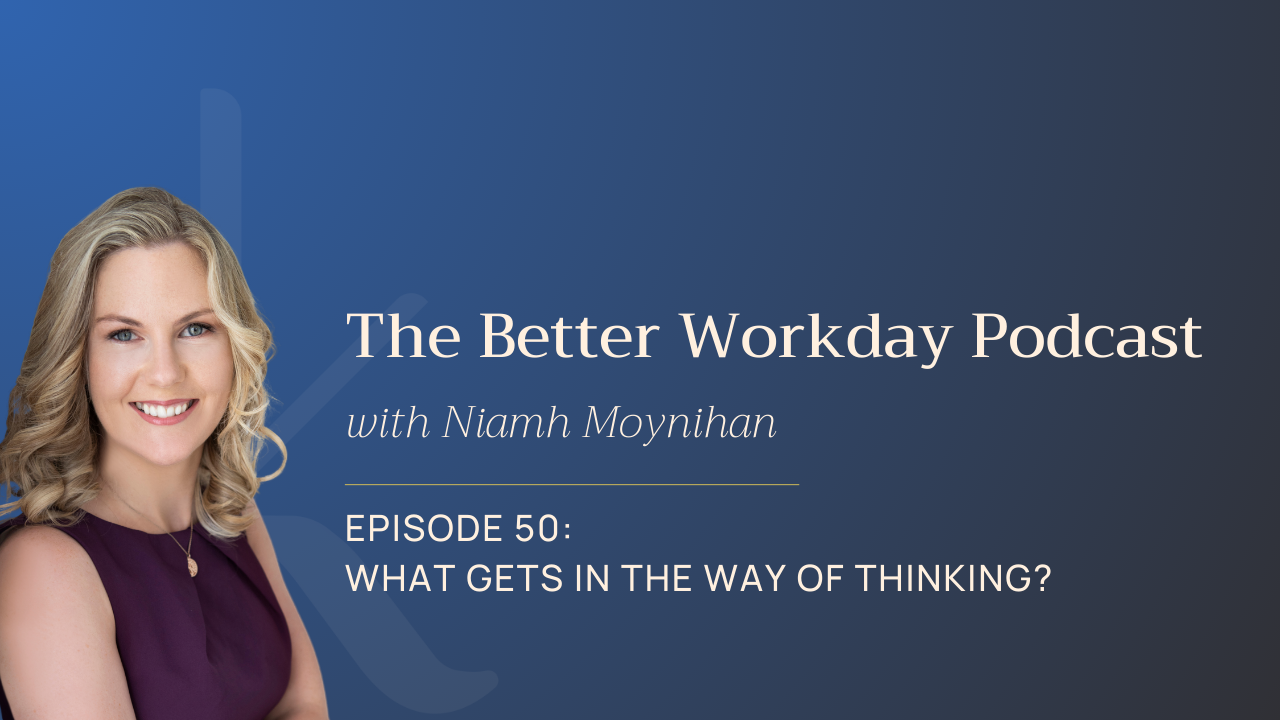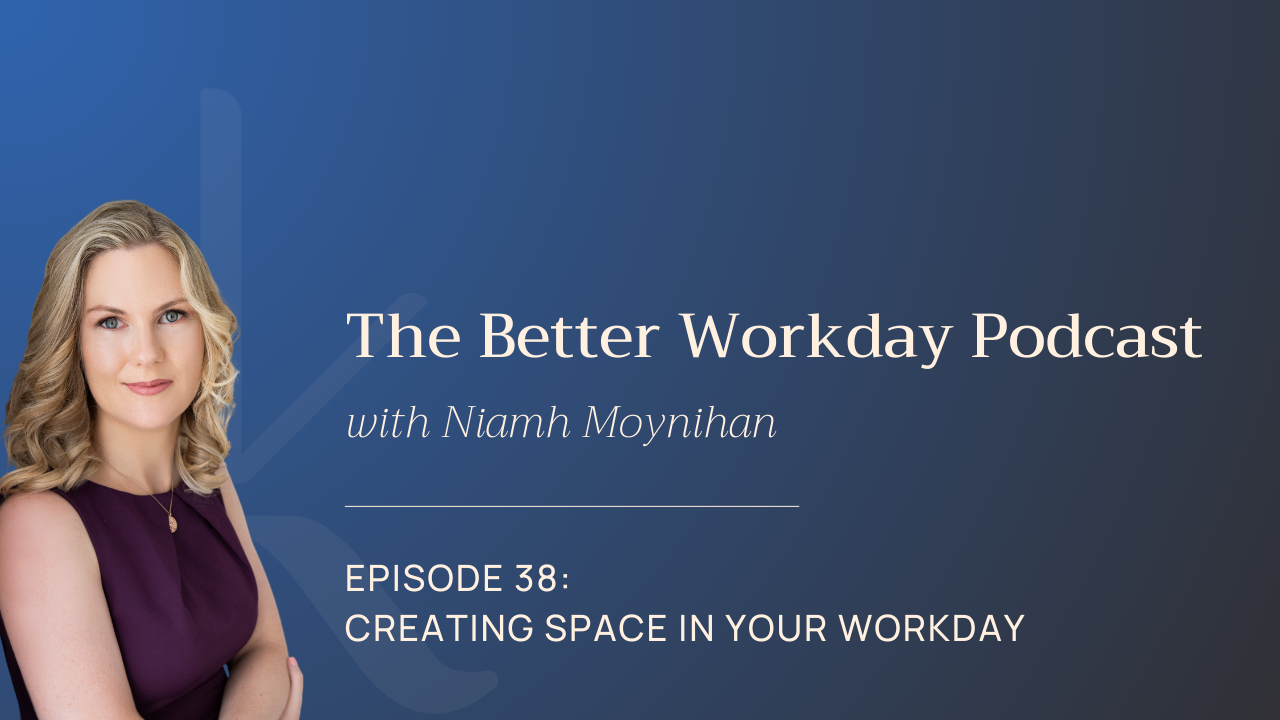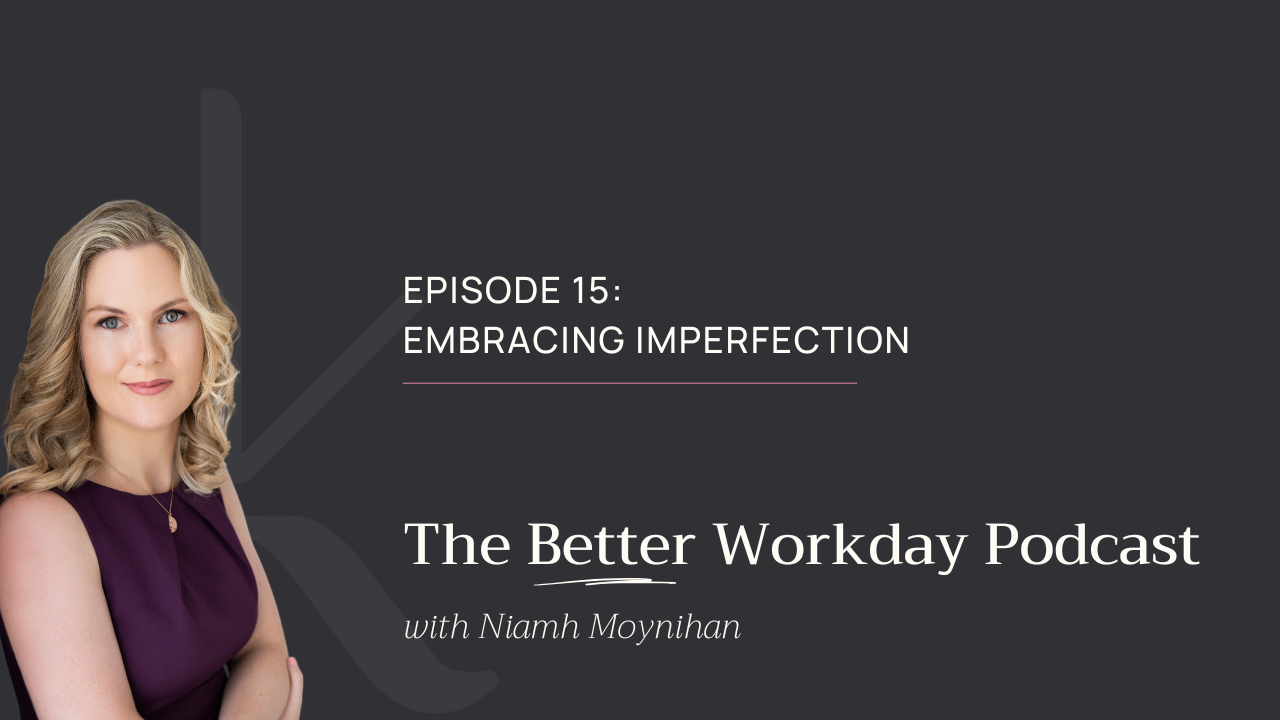Episode 49 | Making Time to Think at Work
Episode Introduction
In this episode, Niamh shares practical ideas on how to create more time to think in your working day. She explains the difference between on-the-job thinking and deep thinking, and outlines four key elements needed to think more effectively: time, place, people, and headspace.
Episode Summary
The Importance of Making Time to Think
Niamh explains that while everyone wants to think more, finding the time to do so is a common struggle. After running several workshops, the main feedback Niamh received was that people appreciated the chance to step away from their daily tasks to think things through. She distinguishes between two types of thinking relevant to the workplace: on-the-job thinking for immediate, day-to-day tasks, and deep thinking for more strategic initiatives and problem-solving. The type of thinking you need depends on your role, but all jobs benefit from creating space to think.
The Four Elements of Thinking
Niamh introduces a framework inspired by Derek Draper's book Create Space, which identifies four key elements for effective thinking: time, place, people, and headspace. She argues that when these four elements are in place, we can make better decisions, feel more in control, and ultimately do better work. Niamh offers actionable tips for each element, from taking two minutes to consider an email response to finding a quiet space to focus. She also suggests that thinking can be a collaborative effort, advising that an outside perspective can help you break out of a "thinking loop".
- Breaks are vital for restoring energy and creating mental space to think.
- The ideal environment for thinking depends on your preference; some people prefer quiet, while others thrive with background activity.
- Talking through a problem with a colleague can provide a new perspective and help you solve problems.
- A "brain dump" can clear your mind of distractions, allowing you to focus on a specific topic.
5 Key Takeaways from the Episode
-
Identify Your Thinking Needs: Consider your role and decide what type of thinking is most beneficial—quick, on-the-job thinking or more strategic, deep thinking.
-
Use Breaks for Big Ideas: Breaks are not just for rest; they provide the mental space needed for solutions and bright ideas to emerge.
-
Find Your Ideal Thinking Environment: Pay attention to the places where you think best, whether that's a bustling café or a quiet room, and seek out those spots when you need to concentrate.
-
Embrace Mind Wandering: Give yourself permission to daydream or let your thoughts wander. This can help you connect ideas and gain clarity without feeling guilty.
-
Use Simple Questions to Reflect: Use the questions "What's going well?", "What's not going well?", and "What can you do differently?" to reflect on both small and large decisions.
About the Host and Podcast
Welcome to The Better Workday Podcast with your host, Niamh Moynihan. Niamh is the founder of Better Workday. She will challenge you to think differently about how you manage your time, energy, attention and relationships at work to be successful while supporting your well-being.
In each episode Niamh shares new insights and practical ideas to help you create a better workday.
Share This Episode
If you found this episode helpful, please share it with a friend or colleague who might also benefit from these tips. If you would like to support the podcast, please subscribe and leave a rating or review.
The Better Workday Podcast on Spotify
The Better Workday Podcast on Apple Podcasts
Related Links and Resources:
Episode 25: The Power of Micro-Breaks
Episode 38: Creating Space in Your Workday
Episode 49 Full Transcript
Welcome to the Better Workday podcast with your host, Niamh Moynihan. In each episode, Niamh shares new insights and practical ideas to help you create a better workday. Hello, hello, and welcome back to the Better Workday podcast. How are you doing?
Today, I want to talk about thinking. It's one of the things that we want to do more of, but we can never necessarily find the time to do it.
I have been delivering workshops and webinars over the last couple of weeks, and they've been with lots of different types of groups, lots of different sectors, and the main theme that came out through all of them was that it gave them a chance to think.
Stepping away from the daily to-do list, the inbox, the meetings, gave them an opportunity to connect with each other, yes, but also just to think things through, in terms of what's working well in their job and even what's working in their lives overall.
And so today, I wanted to talk about this topic of thinking and share some ideas or suggestions around how to create more space to think in your working day.
Now, I want to start by saying that there's two types of thinking. Well, there's lots of types, but for our conversation, there's two types. So there's on-the-job thinking and then there's deep thinking.
And when it comes to work, the type of thinking you need really does depend on your role. I see an awful lot of videos, articles, blog posts, TikTok videos, talking about deep thinking and deep work, but the reality is, for a lot of jobs, that's not always required, or at least it's not required every single week.
So for example, if you are on a helpdesk or if you're a customer success agent, for example, you don't really need to do a huge amount of deep strategic thinking in your day-to-day work, because your job is there to support customers, to answer the phones, and to be present in the moment, and that's what you do best.
Now, on the other hand, you might have somebody who's doing research, who's trying to design a solution to a problem, or maybe who's trying to think about a strategic initiative, and they do need time to think, to think things through more broadly, and to not think of just about this moment in time, but indeed, about the ripple effect of the future.
And so like, these are two, just two simple examples, but they demonstrate that your job demands the type of thinking that you need.
Now, when it comes to outside of work, of course, we could all benefit from a little bit of both, a bit of in-the-moment thinking and a bit of longer-term thinking. But when we're looking at the workday, I don't want you to think that just because everyone's talking about, you know, full days out of the office to reset, that you need that.
I want you to start by looking at your job and asking yourself, "What type of thinking do I need?" And once you've that figured out, it's time then to look at how you can create the ideal conditions for
And because look, while it sounds simple, it's not easy, especially with all these emails coming in, thinking. all the meetings, all of the notifications. And so if we want to do real thinking, even if it is on the job, we want to be able to create the conditions to do it.
Now, I was really inspired by the book Create Space by Derek Draper. It's a fantastic book. I think I've mentioned it in a previous episode.
But in this book, he talks about four different things that we need in order to think. So we need the time, the place, the people, and the headspace, quite simply.
And whether it's trying to think something through, on the day-to-day or trying to make a bigger decision, you know, having these four elements in place allow us to think better.
And when I've been delivering these workshops and these online sessions the last few weeks, when I ask people, "What's the benefit of being able to think things through?" or, "What will happen if you can think better?" everyone comes back with the same thing.
Everyone tells me they can make better decisions, they feel more in control of their day, more in control of their work, and they feel like they're doing better work.
And that, to me, is invaluable, both for yourself, for your team, for the organization. Everyone wins.
So let's break these down and let's have a look. So first of all, we have time. How can you find the time to think?
If it's on-the-job thinking, it could be as simple as taking two minutes at the end of a meeting a minute before replying to an email or to think it through.
It doesn't have to be a big event. It could just be a few moments, a few minutes, really. Now, on the other hand, if you have something bigger to consider, then obviously you need more time.
And that's why breaks, by the way, are so important, because not only do they allow us a chance to restore and recharge, they also give us space and room to think. You know, I know I'm not the only one who's had that bright idea when they're out walking the dog or has solved a problem in the shower, because obviously our brain works in wonderful ways, and when we give it a chance to do so, it helps us to solve our problems.
All we need to do is get a little bit of space away from work. So breaks are really, really important, and you know, if you do need to think something through, taking a longer break from work can really, really serve you.
And when it comes to the place then, really, you know, this could be as simple as finding a quiet spot that helps you think. Oh, well, actually, you might be finding a busier spot, depending on your preference.
And so perhaps one thing you could do after listening to this podcast is pay attention to the different environments you're in during the working week and which of those are more helpful for you to think in.
Some people like a little bit of hustle and bustle in the background, they like a load in of activity and that helps them think.
Others like pure silence.I'm a little bit in the middle, to be honest. It really depends on what I'm thinking about, and so it can vary.
But being aware of that could make a big difference in your day. Let's say, for example, you are in a very busy role that requires you to switch between different topics and different people throughout the day.
Uh, maybe you're in project management or customer success, sales, IT support. All of these roles have so many dimensions to the working day.
And so maybe for you, you want to take, you know, a little few moments of quiet in a quiet place to think things through. On the other hand, if, you know, like me, you spend a lot of time in relative quiet, I work for myself, so I don't have a lot of interruptions, I don't have a lot of meetings,
I actually find it really energizing to go somewhere where there's a lot of background noise to, you know, get the energy flowing and to get my thinking going.
So again, play to your strengths, consider your role, consider your environment, and then identify a few spaces or places that will help you think better.
Now, once you've that, it's time to consider people. A lot of people would look at thinking as a solo activity, but that's not always the case. Have you ever got caught in a loop when it comes to thinking, that you're spinning in circles? Either you can't solve the problem, you can't see a way out of it, you don't know if the solution's going to work, or you don't know if what you're thinking is what is being experienced by other people.
These are all cases for talking through something with somebody else, so thinking together. And having a buddy or a friend at work or at home that you can talk about work or talk about your ideas with is so, so important.
And really, if you're listening to this podcast, you, like me, want to create a better work day, and maybe one thing you can do is be that person to somebody else.
So offer somebody else 15 minutes of your time if they want to chat through anything, and you'll find that it's really rewarding. And quite often, you will end up solving one of your own problems while you're helping someone else solve theirs. It's funny. It's just the way that it works.
So when it comes to the support network or the people who need to think, consider that whether or not an additional perspective, an outside opinion, would actually help in your type of work and in the decisions you have to make.
And then finally, the headspace. Look, you could have all the things in play, but if your head can't focus on what you want to think about, it's no good.
So, you know, quite often we're distracted with 101 things going on in our heads, and it's really hard to pinpoint things down.
And if that resonates with you, one thing you could do is just do a brain dump before you focus on the thing you want to think about.
That could either be writing things down on a scrap of paper. It could be talking with somebody else for five or 10 minutes. It could even be just sending yourself a voice note and just getting it out of your head somewhere else.
And once that's done, then picking a topic or an idea or a problem to sit with and to mull over for your thinking time.
Now, thinking can be thinking about big things, as I said, but it could even be trying to think of the right response to an email.
And I want to take that example to show you how we can use some really simple questions to think things through. So these questions are, what's going well?
What's not going well? And what can you do differently? And let's say it's an email thread. So I need to think about my reply to an email.
And if I want to reflect on that, I could ask myself, what's going well with this conversation so far, if it's, you know, been going on for one or two emails.
Then I'll ask myself, what's not going well? Why is this conversation still happening? Is there lack of clarity?
Is there lack of urgency? Is there lack of information? What's missing here? And once I've identified that, I can ask myself, what can I do differently in this email reply, in this response?
And I can also take those exact same three questions and apply them to much bigger events, much bigger decisions. And that's the beauty about these frameworks. You can really scale them up and down depending on what job you're in and what situation you're in.
Now, one of the things that I think we underestimate the value of these days is just mind wandering, daydreaming, pondering, letting your thoughts just flow along.
You know, when I do full-day workshops, I give people permission to daydream. I tell them that, "Look, if you go off track, which you will, and you go into your own world, it's fine. I'll bring you back in a few minutes." And it's because quite often, there's no other time that people can do that without feeling guilty about it.
And these times of mind wandering are so important, because it's where you sometimes connect dots that you didn't see before.
You might come up with a new idea or just get some clarity. And quite often, I feel that we are cramming our brains so full of information and so full of data and so full of new things to process that we don't give it any space to do its own magic, to connect those ideas and create these new solutions. And so a little bit of mind wandering, I think, can go a long way.
Now, my final thought on this. It's the start of a new quarter. Today, if you're listening to this on the day it's released, it's the 1st of April, so it's the perfect opportunity for you to set a micro goal for yourself.
And maybe that goal for this quarter is going to be to think a little bit more, to create a little bit more space within your day for those moments to step back, pause, and take a look at the situation, to maybe ask for an outside opinion, or maybe just to let your mind wander.
Whichever it is for you, I'd love to hear your thoughts or your comments. You can always reach me by email. The details are in the show notes.
Until next time, stay well and have a better work day. Thank you for tuning in. We hope you enjoyed this episode. The Better Workday Podcast is about helping you have a better workday, so we'd love to hear your thoughts and questions.
You can find our social media details as well as any references from this episode in the show notes.


